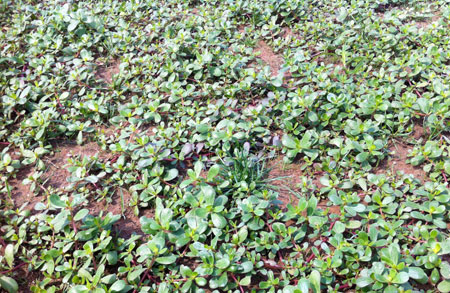Tips for seeding your lawn during summer
Summer conditions make it difficult to establish new grass in lawns. Here are some tips if you can’t wait for fall.
Summer is certainly not the ideal time to establish cool-season turfgrasses due to high temperatures, long day-length, disease pressure and especially weed competition. The optimum growing temperatures for cool-season turfgrasses are in the range from 60 to 75 degrees Fahrenheit, so occasionally during some of our warmer stretches of weather the nighttime temperatures might not even fall within this range. Long day-length or more hours of sunlight results in more hours in the day for drying the soil. Maintaining that delicate balance of soil moisture between too wet and too dry is more challenging during the summer due to the extended drying period.
Periods of high temperature, high relative humidity and heavy rains or overwatering can also make new seedings subject to devastating diseases such as Pythium blight. Finally, weed competition from summer annuals such as crabgrass, goosegrass and broadleaf bandits such as purslane, knotweed, clover and prostrate spurge can quickly take over a new establishment in the summer if herbicides are not used.
If you’re still interested in establishing in the summer, keep on reading. If not, wait for the optimum establishment time of late August and early September.
Weed control
Weed control during summer establishment is definitely one of the keys to success or failure. Tupersan (a.i. siduron) is the traditional standby for controlling weeds during seeded turfgrass establishment. Tenacity (a.i. mesotrione) can also be used safely at the time of seeding. There are also combination products with quinclorac and carfentrazone that provide control of broadleaf weeds in addition to crabgrass and goosegrass. Mesotrione and siduron can be applied on the day of seeding of cool season turfgrasses for control of crabgrass during establishment. Quinclorac + carfentrazone (SquareOne) can be applied early after turfgrass seeding (seven days after emergence) to control crabgrass and broadleaves.
Always read, understand and follow the label directions. Mention or exclusion of specific products does not represent an endorsement or condemnation of any product by Michigan State University.

Weed control is critical for summer turfgrass establishment.
Photo credit: Kevin Frank, MSU
Fertilizer at seeding
At the time of seeding, apply a starter fertilizer at a rate of 1 pound N per 1,000 square feet to help those young seedlings get established. A starter fertilizer is a fertilizer with an N:P2O5 ratio similar to 1:1 or 1:1.5. Under the phosphorus restrictions in place in Michigan, starter fertilizer is still allowed for turfgrass establishment. The maximum amount of phosphorus that can be applied in a single application is 1.5 pounds P2O5 per 1,000 square feet with a yearly maximum of 2.5 pounds P2O5 per 1,000 square feet.
If you have the time to take a soil test, follow the soil test recommendations for establishment. Homeowners can purchase a soil testing kit from the Michigan State University Extension bookstore. More information on soil testing can be found at MSU Soil Test.com.
Mulches for moisture retention
Make sure to keep the seeded area moist throughout establishment. In many cases, this may require watering several times a day. A good mulch cover will help the area stay moist so the site may be watered less frequently. Water lightly when irrigating; there is no need to see water puddling or running off the site.
Dr. Frank's work is funded in part by MSU's AgBioResearch.



 Print
Print Email
Email


